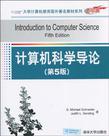计算机科学导论
出版时间:2010-9 出版社:清华大学出版社 作者:(美)施奈德 等著 页数:695
Tag标签:无
内容概要
随着计算机应用的普及,“计算机科学导论”课程不再是教授学生使用字处理器、数据库、电子表格、演示软件和电子邮件了,也不是只限于诸如Web页面设计和交互式图形的“娱乐”应用,而是还应包含诸如算法、硬件设计、计算机组织结构、系统软件、语言模型、计算理论以及计算机社会与伦理问题等知识。对这些核心知识的介绍,将向学生展示整个计算机领域的丰富和华美。它不仅使得学生可以高效地使用计算机和软件,而且还可以鉴赏计算机和软件的创建和实现背后的基本思想。本书就是针对“计算机科学导论”课的这种改革而编写的。本书全面地介绍了该学科的内容,无需读者有计算机科学、程序设计或数学等背景知识。本书不仅适合用作计算机及相关专业学生的课程,也非常适合用作高中计算机科学课程的教材。
作者简介
作者:(美国)施奈德(G.Michael Schneider) (美国)Judith L.Gersting
书籍目录
Chapter 1 An Introduction to Computer Science 1.1 Introduction Special Interest Box: In the Beginning... 1.2 The Definition of Computer Science Speciol Interest Box: Abu Ja' far Muhammad ibn Musa A[-Khowarizmi (a.d. 780-850?) 1.3 Algorithms 1.3.1 The Formal Definition of an Algorithm 1.3.2 The Importance of ALgorithmic Problem Solving PRACTICE PROBLEMS 1.4 A Brief History of Computing 1.4.1 The Early Period: Up to 1940 Special Interest Box: The Original "Technophobia" Special Interest Box: CharLes Babbage (1791-1871) Ada Augusta Byron, Countess of Love[ace (1815-1852) 1.4.2 The Birth of Computers: 1940-1950 Special Interest Box: John Von Neumann (1903-1957) Special Interest Box= And the Verdict Is.., 1.4.3 The Modern Era: 1950 to the Present Special Interest Box: Good Evening, This Is Walter Cronkite Spedal Interest Box: The WorLd's First Microcomputer 1.5 Organization of the Text EXERCISES CHALLENGE WORKLevel1 The Algorithmic Foundations of Computer ScienceChapter 2 ALgorithm Discovery and Design 2.1 Introduction 2.2 Representing Algorithms 2.2.1 Pseudocode 2.2.2 Sequential Operations PRACTICE PROBLEMS 2.2.3 Conditional and Iterative Operations Special Interest Box: From LittLe Primitives Mighty ALgorithms Do Grow PRACTICE PROBLEMS 2.3 ExampLes of ALgorithmic ProbLem Solving 2.3.1 ExampLe 1: Go Forth and Multiply PRACTICE PROBLEMS 2.3.2 ExampLe 2: Looking, Looking, Looking 2.3.3 ExampLe 3: Big, Bigger, Biggest PRACTICE PROBLEMS 2.3.4 Example 4: Meeting Your Match PRACTICE PROBLEMS 2.4 ConcLusion EXERCISES CHALLENGE WORKChapter 3 The Efficiency of ALgorithms 3.1 Introduction 3.2 Attributes of ALgorithms PRACTICE PROBLEMS 3.3 Measuring Efficiency 3.3.1 Sequential Search 3.3.2 Order of Magnitude--Order n Special Interest Box: FLipping Pancakes PRACTICE PROBLEM 3.3.3 SeLection Sort PRACTICE PROBLEM 3.3.4 Order of Magnitude--Order n2 Special Interest Box: The Tortoise and the Hare PRACTICE PROBLEM 3.4 AnaLysis of ALgorithms 3.4.1 Data CLeanup ALgorithms PRACTICE PROBLEMS 3.4.2 Binary Search PRACTICE PROBLEMS 3.4.3 Pattern Hatching 3.4.4 Summary PRACTICE PROBLEM 3.5 When Things Get Out of Hand PRACTICE PROBLEMS 3.6 Summary of Level 1……Level2 The Hardware WorldLevel3 The Virtual MachineLevel4 The Software WorldLevel5 ApplicationsLevel6 Social Issues in Computing
章节摘录
插图:The discussions in Level 1 assume that our algorithms are executed bysomething called a "computing agent," an abstract concept for any entity thatcan effectively carry out the instructions in our solution. However, in Level 2(Chapters 4-5), "The Hardware World," we want our algorithms to be executedby "real" computers to produce "real" results. Thus begins our discussion ofhardware, logic design, and computer organization. The initial discussionintroduces the basic building blocks of computer systems——binary numbers,Boolean logic, gates, and circuits. It then shows how these elementary conceptsare used to construct a real computer using the classic Von Neumann architec-ture, including processors, memory, buses, and input/output. It presents a typ-ical machine language instruction set and explains how the algorithms of Level1 can be represented in machine language and run on the Von Neumann hard-ware of Level 2, conceptually tying together these two areas. It ends with a dis-cussion of important new directions in hardware design——multicore andmassively parallel machines.By the end of Level 2 students have been introduced to some basic con-cepts in logic design and computer organization, and they understand andappreciate the enormous complexity of these areas. This complexity is themotivation for Level 3 (Chapters 6-8), "The Virtual Machine." This sectiondescribes how system software produces a more friendly, user-orientedproblem-solving environment that hides many of the ugly hardware detailsjust described. Level 3 looks at the same problem discussed in Level 2,encoding and executing an algorithm, but shows how much easier this is ina virtual environment containing software tools like editors, translators, andloaders. This section also discusses the services and responsibilities of oper-ating systems and how operating systems have evolved. It investigates oneof the most important virtual environments in current use——a network ofcomputers. It shows how systems such as the Ethernet, Internet, and theWeb are created from computers linked together via transmission media and communications software.
编辑推荐
《计算机科学导论(第5版)(影印版)》是大学计算机教育国外著名教材系列。
图书封面
图书标签Tags
无
评论、评分、阅读与下载
用户评论 (总计3条)
- 书很正点 快递也很给力 总之我很满意!
- 内容很不错,就是英文的,英语基础不好的人可以选购中文版
- 很好的导论书。作者叙述表达很好。看它的前言你对它的优点会有了解的。
